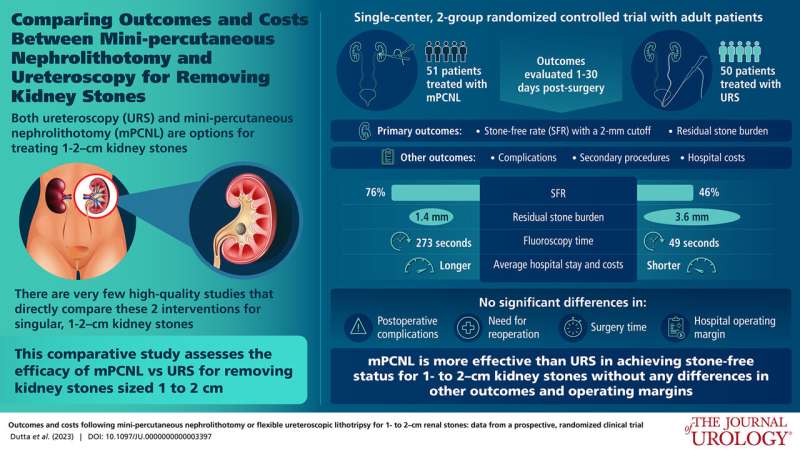This article has been reviewed according to Science X's editorial process and policies. Editors have highlighted the following attributes while ensuring the content's credibility:
fact-checked
peer-reviewed publication
trusted source
proofread
'Mini-PCNL' surgery has higher stone-free rate in treating intermediate-size kidney stones, finds randomized trial

For patients with kidney stones measuring one to two centimeters, a technique called mini-percutaneous nephrolithotomy (mini-PCNL) provides a higher stone elimination rate than another minimally invasive procedure called ureteroscopy (URS), concludes a randomized trial in the Journal of Urology.
"In our clinical trial, mini-PCNL was more likely to achieve stone-free outcomes, compared to URS," comments senior author Jorge Gutierrez-Aceves, MD, of the Cleveland Clinic. "In patients with intermediate-sized kidney stones, mini-PCNL may offer a more effective procedure, with similar safety and cost impact."
Trial compares minimally invasive surgeries for intermediate stones
Kidney stones are one of the problems most commonly seen by urologists. In current AUA guidelines, conventional PCNL surgery is recommended for patients with stones larger than two centimeters, while less-invasive treatments are recommended for symptomatic stones smaller than one centimeter.
However, there is ongoing debate over treatment for intermediate-size stones—measuring one to two centimeters. In the URS procedure, kidney stones are approached using a small instrument (ureteroscope) placed through the urethra and bladder.
Mini-PCNL offers an alternative approach, with treatment carried out through a small incision (sometimes called a keyhole incision) in the patient's side. Previous studies comparing the outcomes of URS and mini-PCNL have had important limitations.
In the new study, 101 patients with one- to two-centimeter kidney stones were randomly assigned to treatment with URS or mini-PCNL. All patients had a single intermediate-sized stone in one kidney. In both procedures, once the surgeon visualized the stone through instruments placed into the kidney, the stone was fragmented using a laser and removed using a basket device.
Mini-PCNL has higher stone-free rate than URS, with similar safety
The main outcome of interest was the stone-free rate, defined as no residual stone larger than two millimeters on postoperative CT scans. By this definition, 76% of patients were stone-free after mini-PCNL, compared to 46% after URS. The mini-PCNL group also had a lower total volume of residual stone fragments after treatment: 3.6 versus 1.4 millimeters.
Postoperative complication rates were low in both groups: 2% after mini-PCNL and 4% after URS. Other safety outcomes were similar as well, including the need for a second procedure within 30 days and changes in creatinine as an indicators of kidney function.
In this study, patients in the mini-PCNL group spent a night in the hospital, compared to none in the URS group. The mini-PCNL procedure had higher costs compared to URS. However, these differences were offset by a nonsignificant operating margin between groups.
The study provides new information for the "nuanced" decision-making process for treatment of kidney stones measuring one to two centimeters. The researchers authors note their study is the largest North American randomized trial to directly compare mini-PCNL versus URS for this group of patients.
"Our results suggest that mini-PCNL is more likely to render patients stone-free than URS, with no difference in complications, surgical times, and operating margins," Dr. Gutierrez-Aceves comments. The researchers also discussed the cost impact of mini-PCNL, including the impact on equipment and hospitalization costs.
More information: Rahul Dutta et al, Outcomes and Costs Following Mini-percutaneous Nephrolithotomy or Flexible Ureteroscopic Lithotripsy for 1-2–cm Renal Stones: Data From a Prospective, Randomized Clinical Trial, Journal of Urology (2023). DOI: 10.1097/JU.0000000000003397





















